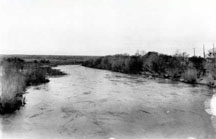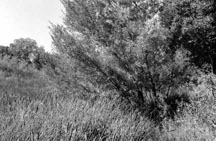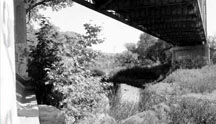| (1917). Thompson took this downstream view of
the Mojave River from the deck of a highway bridge. Most of the trees appear
to be Goodding willows, leafless in the winter season, and cottonwoods appear
at several places, particularly on river right (right side). The channel
is unconfined by bedrock here and is very wide, possibly in response to
recent floods (David Thompson 443, USGS Photo Library). |
(October 24, 2000). Because the bridge was replaced
at a higher elevation than the one that was present in 1917, our match is
too low. Seep willow and cattails dominate the view, with mature cottonwood
trees appearing behind them to the right and left (Dominic Oldershaw, Stake
2112b). |
| (1917). In this upstream view from the same bridge,
the main railroad between Salt Lake City and Los Angeles is at left. The
shrubs along the channel appear to be mostly coyote willow and seep willow.
What appear to be small cottonwood trees are in the middle distance (David
Thompson 444, USGS Photo Library). |
(October 24, 2000). Because the old bridge was
replaced at a higher deck elevation, our match is from a bridge pier and
is too low. Riparian vegetation has increased dramatically, blocking most
of the view. A few cottonwoods appear on both river left and right, and
various herbaceous riparian species are in the foreground lining the perennial
stream. Beaver ponds also are present, and the beaver are killing some of
the smaller trees in the upstream reach. The tree in the foreground is a
sycamore, and several other sycamores are in the reach upstream. The occurrence
of sycamore is highly unusual for this part of the Mojave River (Dominic
Oldershaw, Stake 2112a). |




